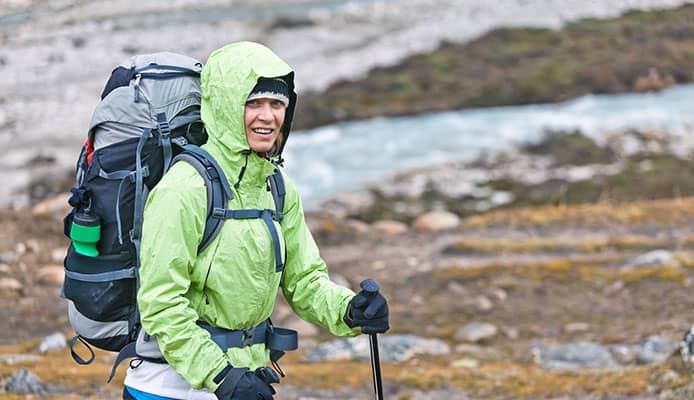
Backpacks are indispensable gears for hikers, campers, backpackers, and even ordinary folks going to school or work. Every person will have certain criteria as to what makes a good backpack, but they all agree that a great backpack is one that can be easily carried and is capable of keeping all your valuables safe. For outdoor enthusiasts, additional criteria would be its ability to keep your belongings dry in wet conditions.
There are a few things more frustrating than arriving at your destination and finding out that your clothes and gear are soaking wet after crossing the river or hiking through light rain. For those reasons, many adventurers choose a water-resistant or waterproof backpack. Unfortunately, many of them have trouble choosing one. There are water-resistant bags, waterproof bags, rainproof backpacks, and so on, and the choices can often seem confusing to many people. So what’s the difference between water-resistant vs. waterproof backpacks and which one do you need? To answer those questions, let’s take a closer look at the two.
Water-resistant vs. Waterproof Backpacks
Backpacks labeled as ‘water-resistant’ means that the bag will hold up against the water. However, at some point, the water will eventually get through the backpack and cause the items inside to become wet. That said, water-resistant backpacks do not provide complete protection against water, especially when we’re talking about heavy rainfalls or being submerged in water. Water-resistant backpacks are not completely waterproof and are only able to resist the entry of water to a certain degree.
Conversely, the term ‘waterproof’ means that water shouldn’t be able to enter the backpack. This is even when it is submerged in water (which can happen occasionally to those who are just getting started with white water kayaking). Thus, you can accidentally drop your waterproof backpack into the water and have the confidence that the contents will all be bone dry after you take it out of the water and open it.
Water-resistant vs. Waterproof Backpacks: Materials
One key factor that determines whether a backpack is water-resistant or waterproof is the material it is made from. In this regard, let’s take a look at two important components of a backpack – the fabric and the zipper – and how the materials they’re made from affect the backpack’s overall ability to keep water out.
Water-resistant vs. Waterproof Fabric
Most water-resistant backpacks are usually made from either polyester or nylon and cotton. These types of fabrics are woven and if you look closely you should be able to see the individual strands used to create the fabric. In many cases, these gaps between these fibers can provide a water entry. Some manufacturers use fabrics with fibers that are tightly woven, but this doesn’t make it waterproof which means that you may still need to use a backpack rain cover. Such fabrics are capable of preventing raindrops and splashes of water from entering the bag, but it won’t work well when the bag is completely submerged in water or when under strong pressure (such as when you’re crossing a cascading waterfall).
On the other hand, waterproof bags are made from PVC or Thermoplastic Polyurethane (TPU) which are 100% waterproof since they aren’t made from woven fibers. Aside from lacking the gaps created by woven fabrics, these also have very small pores or openings, so much so that even small water molecules aren’t able to pass through.
Water-resistant vs. Waterproof: Zippers
The zippers on a backpack are one of the main entry points of water. A standard zipper has small openings between the teeth where water can pass through even when closed. Besides, the more zippers there are in a backpack, the more susceptible it will be to water penetration since it provides numerous entry points for the water.
There are water-resistant bags that have splash guards or flaps that cover the zippers. These are usually just a piece of fabric that covers the exposed teeth and keeps the water from entering or falling through the gaps.
Some manufacturers make use of coated zippers which are more water-resistant than regular zippers. However, water-resistant zippers are still different from actual waterproof zippers, the latter being better at keeping moisture out and more expensive. Beware also of manufacturers who advertise their products with waterproof zippers. To check, look at the bag claiming to have waterproof zippers. If the bag is sewn, it is very unlikely that the manufacturer used waterproof zippers. After all, why put a very expensive zipper on a less expensive water-resistant fabric?
Water-resistant vs. Waterproof: Construction
Another thing that differentiates water-resistant and waterproof backpacks is the construction. Water-resistant and waterproof backpacks are made differently as we’ll see below.
One of the things that you’ll notice concerning water-resistant backpacks is that the fabric is sewn together. This process then leaves lots of needle holes and consequently, more entry points for water. Sure, these holes may be sealed with silicon or a seam tape, but only will be a matter of time before these protective coverings will break down. So if you see a backpack claiming to be waterproof, check that the fabric is not sewn together.
Waterproof backpacks, on the other hand, are made differently. They aren’t sewn together as with water-resistant backpacks and are instead welded together. After all, there’s no point in using 100% waterproof fabric if you’re just going to bore needle marks through it. So to achieve 100% waterproofness, manufacturers fuse the fabrics through ultrasonic welding or RF welding.
With this process, the different pieces of waterproof fabric are fused by ultrasonic waves at a molecular level, thus ultimately creating a bag that seems to have been made from a single piece. The bonded area is actually stronger than the mother material and leaves no holes for water to enter.
Water-resistant vs. Waterproof: Coating
Aside from using water-resistant and waterproof fabrics, many rainproof backpacks also have a coating that gives them added protection against moisture. More often than not these coatings are composed of polyurethane (PU) or polyvinyl chloride (PVC) or thermoplastic elastomers (TPE). Depending on the manufacturer, one or two layers of these coatings are applied on the backpack’s fabric, with some even applying up to three layers.
Generally, this coating is sprayed or laminated on by the factory’s fabric supplier before it gets to the factory or manufacturing facility. Also, a Teflon coating will be occasionally applied to the front of the surface of the fabric to help water bead up and roll off the surface.
You might also like: Perfect Waterproof Backpacks
ZIP Code
The IP Code or Ingress Protection Code is an international standard code that classifies the level of protection something offers against intrusion from physical things (i.e. dust, and dirt) and water. The code consists of two numbers. The first one is for protection against physical objects and is rated between 0 and 6. The second number indicates the level of water protection offered, rated between 0 and 9. These two numbers sit side by side along with the IP initials.
For instance, if you see a bag with the code IP61 (IP six-one), it means that the bag is dust tight (offers complete protection against dust entry) but has low water protection, which is often enough if you’re hiking with your dog on a sunny day. On the other hand, a bag with the code IP19 (IP one-nine) will have poor protection against dust but can handle strong water pressure and can be immersed in water to depths of 1-3 meters (depth may vary depending on the manufacturer or brand). So if you have a product that is near a 9, then you can have confidence that it’s extremely unlikely any water or liquid is going to enter the bag.
So Which One Do I Buy?
So after knowing the differences between a water-resistant and a waterproof backpack, you should have a good idea of which bag to buy. However, if you’re still not sure, then considering the following might help: how much water exposure can you expect during your adventure?
Before making any decision, you must have a proper understanding of water exposure in the place you’re going. Needless to say, the more water exposure you expect, the better off you’ll be with an actual waterproof backpack.
If you are going to places or doing activities where water exposure is limited to low levels of moisture like hiking in a cold or misty mountain or kayaking in calm waters where your biggest concern is splashing water, then a water-resistant backpack should suffice.
On the other hand, if you are going to places where there is a high probability of a heavy downpour or extremely wet conditions, or doing a sport or activity where there is a high chance of submersion like white water rafting, then you’ll definitely want a waterproof backpack.
Globo Surf Overview
As can be seen above, water-resistant vs. waterproof backpacks aren’t the same. Though both of them can fend off the water, they are made from different materials and have different construction processes. By considering these, you’re more likely to make a better purchasing decision and thus end up with the correct bag that will meet the requirements and demands of your trip or activity.


